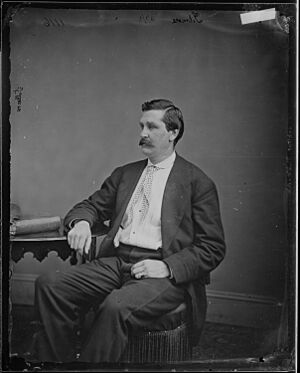Harry Gilmor facts for kids

Harry Ward Gilmor (born January 24, 1838 – died March 4, 1883) was a brave and well-known Confederate cavalry officer during the American Civil War. After the war, he became the Baltimore City Police Commissioner in the 1870s. Gilmor was famous for his daring raids, like "The Magnolia Station Raid" in July 1864. His group of fighters became known as "Gilmor's Raiders."
Contents
Harry Gilmor's Early Life
Harry Gilmor was born at "Glen Ellen," a large family estate in Baltimore County, near Towsontown, Maryland. His parents were Robert Gilmor and Ellen (Ward) Gilmor. Harry was one of eleven children in his family.
Gilmor's Role in the Civil War
During the American Civil War, Harry Gilmor was part of a group called the "Baltimore County Horse Guards." After some riots in Baltimore in April 1861, he was arrested and sent to Fort McHenry. This happened when Federal troops took control of Baltimore.
After he was released, Gilmor went South and joined the Confederate forces. He fought under General Turner Ashby for a while. He was captured again during the Maryland Campaign and spent five months in prison.
In June and July 1863, during the Gettysburg Campaign, Major Gilmor was put in charge of the First Maryland Cavalry and Second Maryland Cavalry. These units supported an infantry brigade led by Brigadier General George Steuart. Gilmor was also the chief of police for the town of Gettysburg while the Confederates occupied it from July 1 to July 4.
The Daring Magnolia Station Raid
In July 1864, the Confederate army, led by General Jubal Early, planned a major attack on Washington, D.C.. As part of this plan, Colonel Gilmor's command, along with other Confederate troops, carried out raids around Baltimore.
On July 10, 1864, Major Harry Gilmor was given 135 men from the 1st and 2nd Maryland Cavalry. Their mission was to cross Baltimore County into Harford County and destroy a railroad bridge. This bridge belonged to the Philadelphia, Wilmington, and Baltimore Railroad at Magnolia Station, near the Gunpowder River.
While on this mission, Gilmor stopped to visit his family at their home, "Glen Ellen." Early on July 11, Gilmor's advance group passed the home of Ishmael Day. Day was a strong supporter of the Union and had hung a large United States flag outside his house. When Gilmor's men told him to take it down, Day refused. A sergeant tried to take the flag down himself, and Day shot him. Day then ran away and hid. Gilmor's men then burned Day's home and barn. The sergeant was taken to a hotel but sadly died later.
Around 8:40 in the morning on July 11, Gilmor's cavalry reached Magnolia Station. They stopped two trains coming from Baltimore. After letting the passengers off, the soldiers set fire to the second train. They then pushed the burning train onto the railroad bridge. The fire destroyed part of the bridge. On the first train, a Union officer named William B. Franklin was traveling while recovering from an injury. This raid was considered one of the most daring actions by cavalry during the war.
Later Military Actions
Eventually, Gilmor was ordered to take his command to Hardy County, West Virginia, to attack the Baltimore & Ohio Railroad. There, he was captured on February 4, 1865. He was held as a prisoner of war at Fort Warren in Boston Harbor until July 24, 1865. This was several months after the war officially ended.
Life After the War
After the war, Harry Gilmor moved to New Orleans. He married Mentoria Nixon Strong, and they had three children.
Gilmor wrote a book about his war experiences called "Four Years in the Saddle," which was published in 1866. He soon returned to Maryland and was elected a colonel in the reorganized Maryland National Guard.
From 1874 to 1879, he served as the Baltimore City Police Commissioner. This was a very important job in the city. Harry Gilmor died in Baltimore due to problems from a war injury to his jaw. He was buried in Loudon Park Cemetery in Baltimore. His funeral was a large event, with many important people attending to honor him.
Today, there is a Gilmor Street in West Baltimore, named after his family. Also, the Gilmor Homes, a well-known public housing project in Baltimore, is named for the Gilmor family.

